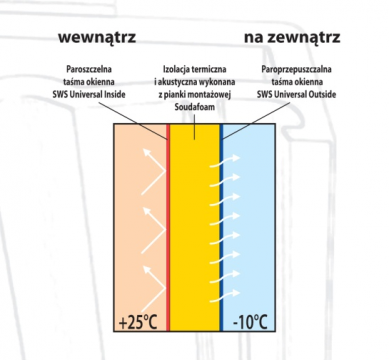Installation
Factory installation service for MFOiD windows is performed by highly qualified and selected groups of installation engineers.
Our factory installation service is:
- Professional measuring and expert consulting.
- Applicable protection of a room before installation work.
- Installation carried out to instruction manual and the strictest standards.
- Highest quality materials and installation tools.
- Customer training on the use of the product, its functions and maintenance.
WARM INSTALLATION:
Warm installation of windows, i.e. an energy-efficient installation method (often called a
three-layer installation) is a method of window installation which ensures perfect insulation characteristics of the window and wall joint location by placing a tape on the outside and inside of a window opening to protect thermal insulation layers.
Even the cutting edge quality windows will not ensure correct parameters if they are not installed correctly.
Warm installation is recommended for all types of windows. It enables lowering the costs of energy consumption, improves a room's microclimate and prevents ugly patches, water marks or fungi from forming around windows.
The area where window meets the outside wall is the point particularly prone to heat loss and build-up of humidity which is why selecting good seat and correct sealing of window joinery and building structure joint is critical.
Advantages of warm installation performed by a team of professional installers:
- Limiting the uncontrollable heat loss which translates in to lower heating costs.
- Lowering noise level inside house.
- Prevents mould and fungi from forming.

| PL |
EN |
| Wewnątrz |
Inside |
| Na zewnątrz |
Outside |
| Paroszczelna taśma okienna SWS Universal Inside |
Vapour-proof window tape SWS Universal Inside |
| Izolacja termiczna i akustyczna wykonana z pianki montażowej Soudafoam |
Heat and acoustic insulation made of Soudafoam caulking foam |
| Paroprzepuszczalna taśma okienna SWS Universal Outside |
Breather window tape SWS Universal Outside |
Internal seal (vapour-proof tape) serves as a "shield" for thermal insulating layer by preventing water vapour and humidity penetration from the outside.
Middle layer (caulking foam) acts as a heat and sound insulation.
Outside seal (breather tape) prevents humidity from entering inside but enables forcing humidity outdoors.
By using warm installation method you get not only thermal comfort but also prevent potential damping of insulation and structural materials which in turn may result in mould formation in the location of joint between window and wall as well as protect against walls against frost damage during winter.
